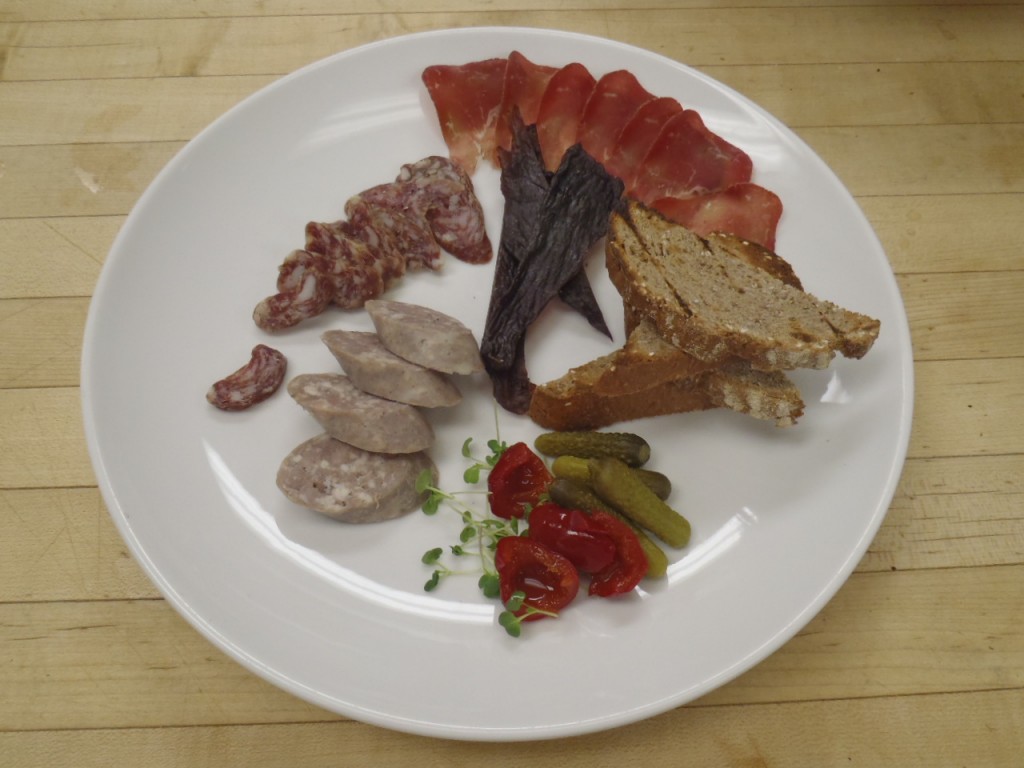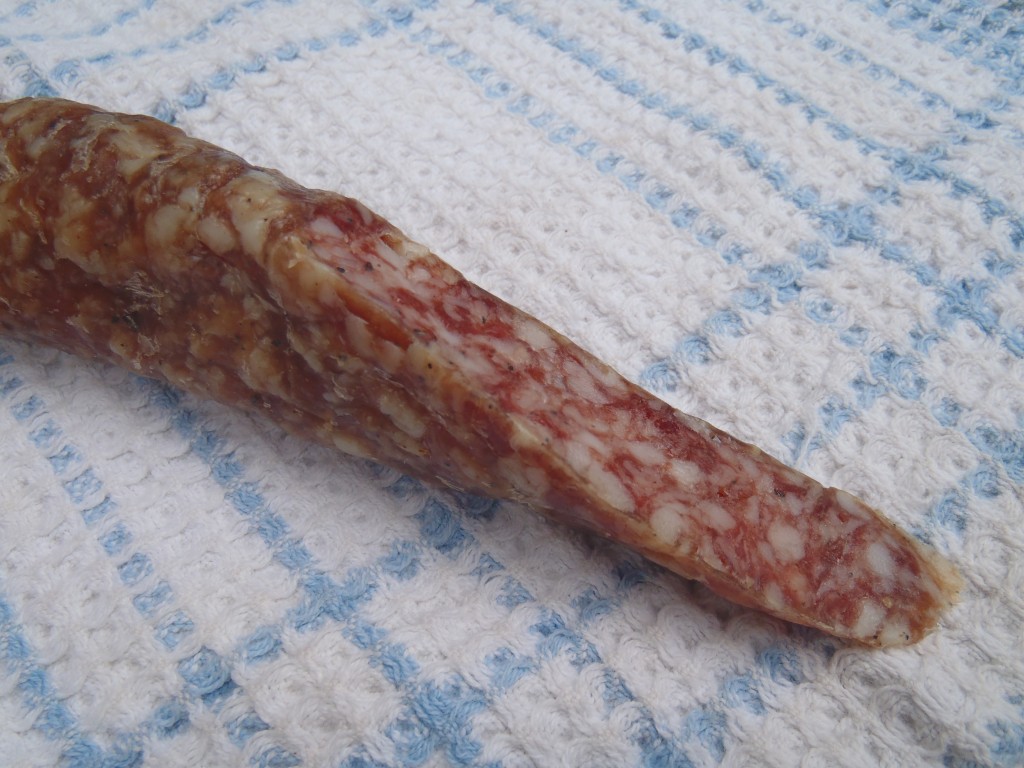This is the information I provide students in my Charcuterie at Home class, which I run a few times a year for Metro Continuing Education.

What is charcuterie?
- Charcuterie is a French word, from char for flesh or meat, and cuit for
cooked. - Originally this was a medieval guild that was allowed to prepare certain cooked
meat dishes like pâté and terrine. - These days it broadly refers to cured meat, whether bacon, ham, salami,
prosciutto, or even duck confit and jerky. It also encompasses other meat preparations like fresh sausages. - Most charcuterie techniques – salt-curing, smoking, and air-drying – were
developed as a way to preserve meat. - Even though we now have ways to pasteurize, refrigerate, and freeze
meat, we still use these ancient techniques because they are so delicious!
Types of Charcuterie
- Most classic charcuterie is make from pork, but there are several examples made from beef, duck, and other animals.
- Charcuterie can be made from whole, intact muscles, or ground meat
- eg. of whole muscle charcuterie: bacon, ham, prosciutto, coppa
- eg. of ground meat charcuterie: salami, mortadella, pepperoni
- After curing, charcuterie is either cooked, or air-dried (ie. hung in a cellar to dry out, after which it is eaten raw)
- eg. of cooked charcuterie: bacon, ham, mortadella
- eg. of air-dried charcuterie: prosciutto, coppa, salami
Important First Principles
When making charcuterie…
- Use the highest quality meat you can afford (see Resources below).
- Weigh all ingredients, especially salt and curing salt. If you don’t already have one, you should invest is a good digital scale with precision to the gram. I use a Starfrit scale that I got at London Drugs for less than $30 if my memory serves me. This is partly for food safety (ensuring we always have the right amount of salt) and partly for consistency.
- Carefully control time and temperature as per your recipe.
- Invest in a good reference such as Charcuterie by Michael Ruhlman and Brian
Polcyn (again, see Resources below).
Salt and Curing Salt
- All charcuterie is made by applying salt to meat.
- Salt preserves meat by killing or disrupting micro-organisms.
- Table salt (NaCl) was used for thousands of years to preserve meat. Sea salt, sel gris, fleur de sel, Maldon, Himalayan pink salt…. these are all NaCl, just with different mineral impurities that give them subtly different flavours and colours.
- In medieval Europe a new type of naturally-occurring salt was discovered, saltpeter, which is potassium nitrate (KNO3). People found that using it in very small amounts improved their cured meats. It affected the meats in the following ways:
- produced a distinctive, piquant flavour
- gave the meat a bright, rosy pink colour
- preserved the meat better than normal table salt (for instance, it prevents oxidation and rancidity)
- Later it was discovered that microbes in the meat convert the nitrate in saltpeter to nitrite, and that this is the actual active ingredient.
- Modern curing salt is sodium nitrite (NaNO2). It is available at butcher supply shops like Halford’s Hide, Butchers and Packers Supplies, CTR Refrigeration
Cure #1 vs. Cure #2
- Nitrate can act as a “slow-release” cure, as it is slowly converted to nitrite by micro-organisms in the meat.
- Air-dried preparations that will spend weeks or months in a celery (eg. salami) are usually treated with a combination of nitrite and nitrate.
- Preparations that are cured and cooked over the course of a week (eg. bacon and ham) are usually treated with nitrite.
- In the US, curing salts are usually died pink so that they are not confused with table salt. For this reason, curing salt is often called pink salt, or tinted cure.
- Note that there are several types of table salt that are pink, but are not curing salt! Eg. pink salts from Hawaii and the Himalayas. This should not be used in charcuterie!
- Common names for nitrite mixtures: Cure #1, FS Cure #1, pink salt, tinted cure dmix (TCM), TCM #1, Prague Powder
- Common names for nitrate mixtures: Cure #2, FS Cure #2, Salami Cure, TCM #2
- If there is any uncertainty, the package should clearly list the ingredients and their percentage weight.
A Quick Word on “Nitrite-Free” Charcuterie
- In recent years nitrites have been portrayed as unsafe, even carcinogenic. Harold McGee, one of the world’s foremost food scientists, writes in his book On Food and Cooking: “At present there’s no clear evidence that the nitrites in cured meats increase risk of developing cancer. Still, it’s probably prudent to eat cured meats in moderation and cook them gently.”
- Even though there is no proven link, there are now many “nitrite free” products in the super market. The disturbing part of all this is that these products always contain something like fermented celery extract, which contains nitrites! In other words there are nitrites in the product, but they don’t appear in the ingredients list because they are an elemental component of the celery extract. It’s a bit like like saying that your hot dog is “sugar free” because you didn’t sprinkle white sugar on it, even though there is sugar in the wiener and the bun and the ketchup and the mustard. Always…
Rub-Curing vs. Brine-Curing
- Traditionally most charcuterie was simply rubbed with or packed in dry salt.
- Many modern charcuterie items are cured by being submerged in a brine,
which cures faster and plumps the meat. - Generally, lean cuts like pork loin and leg benefit from brine, while fattier cuts like belly are best rubbed.
Brine Basics
- We heat the water to dissolve the salt and sugar.
- Chill the brine thoroughly before submerging the meat.
- Make sure there is enough brine to keep the meat fully submerged.
- It may be necessary to weigh the meat down to keep it from bobbing at the surface.
- Brine penetration: larger cuts of meat benefit from a small injection of brine into the centre at the start of curing.
- Brine time: a good rule of thumb is to leave the meat submerged for 12 hours for every pound of meat (eg. a 10 lb ham would cure in 5 days).
Rub-Cure Basics
- Rub-cures should be periodically overhauled: this is simply redistributing
the cure over the surface of the meat. - Rub curing takes longer – even relatively thin pork belly is left in contact with a rub-cure for a week.
Smoking
- We make the distinction between hot-smoking and cold-smoking.
- During hot-smoking the meat is held between 200°F-250°F and is slowly
cooked as it is exposed to the smoke – bacon and ham are hot-smoked. - Cold-smoking is done at 100°F or lower so that the meat remains raw – air-
dried products like speck are cold-smoked.
- During hot-smoking the meat is held between 200°F-250°F and is slowly
- Pellicle formation: after rinsing the cure off the meat, dry the surface of the meat by patting with a clean dish towel. Set the meat on a wire rack and leave it uncovered in the fridge overnight. The surface of the meat will dry and become slightly tacky: this will help smoke adhere to the surface.
- We usually smoke with hardwood (eg. maple, apple, hickory, mesquite, cherry) though there are some traditional preparations smoked with evergreen like juniper or fir (most notably true Black Forest ham)
- Usually 2/3 of the wood chips are soaked in cold water for 30 minutes prior to smoking – this helps the smoulder longer.
- The key is to have intense heat that can smoulder the chips, while keeping the ambient temperature of the chamber in the ranges mentioned above.
- For more info and a thorough explanation of how to smoke meat using a barbecue, see my post called Smoking Meat at Home.
Air-Drying
- Air-dried products are cured (typically with a rub-cure), then held at cellar
temperature and humidity until they have lost a good deal of their moisture
content. - Examples: guanciale, coppa, lonzo, lonzino, lardo, pancetta, prosciutto,
salami, speck, bresaola, bündnerfleisch - The key to this process is controlling temperature and humidity:
- Too moist and the moisture will not leave the meat and mold will grow on the surface
- Too dry, and you may see case hardening: the outermost part of the meat will dry so thoroughly as to become impermeable, locking moisture within.
- Ideal temperature range is 12-15°C.
- Ideal humidity range is 60-70% humidity.
- Highly recommended product: Auber Instruments Temperature and Humidity Controller.
- Friendly mold cultures can be applied to the outside of the meat to prevent colonization by less-desirable microbes.
- Hang-times vary from a couple weeks for slender sausages to one or two
years for prosciutto.
Resources
Meat
- Acme Meat Market – These guys source quality meat and are great with special requests and cutting instructions.
- Nature’s Green Acres (City Centre Market) – Probably the most unique and ethically- and sustainably-raised meat in the province. This is the meat I use in my home.
- Pine Haven Meat Shop – Pine Haven is a Hutterite colony near Wetaskiwin. This is the meat I use at work at Elm Catering and Salz Bratwurst Co. You can order their meatonline for pick-up at Ben’s Meat and Deli.
Equipment and Material
- Butchers and Packers Supplies (12225 Fort Road)
- Halford’s Hide (8629 – 126 Avenue)
- CTR Refrigeration (10456 – 170 Street)
- www.sausagemaker.com
Books and References
- Charcuterie by Michael Ruhlman and Brian Polcyn – One of the most influential food books published in the last 20 years, this is an amazing primer on curing, grinding, sausage-making, and air-drying. Lots of theory, and an expansive collection of solid recipes.
- Charcuterie by Fritz Sonnenschmidt – An old-school reference by a German-born Master Chef. I like this book because it includes some lesser-known old world preparations like Pressack, Leberkäse, and Kassler Rippchen.
- Salumi by Michael Ruhlman and Brian Polcyn – A very thorough treatment of traditional air-dried Italian preparations like salami, coppa, pancetta, and prosciutto.
- The Button Soup Charcuterie page. Basic theory and lots of recipes.

